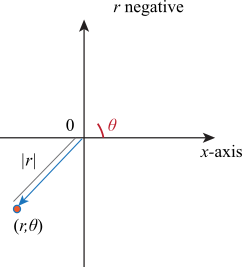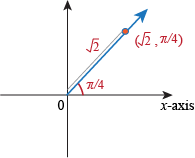It's a hot summer evening. Bob has been training for a triathalon and needs a major calorie intake. He finished his dinner of pizza and hot dogs, but he still has room for dessert, so he eyeballs that key lime pie his neighbor brought over for him yesterday.
He walks over to the counter, licks his lips, and picks up a knife. He drives the knife right into the center of the pie and makes a cut. He turns the pie, places the knife in the center again, and cuts himself a heathy-sized wedge.
Polar coordinates are the first choice for describing circular things, key lime pie notwithstanding.
We often describe the location of a point by giving its rectangular or Cartesian coordinates (x, y). The first coordinate x describes how far we travel to the right (or left) of the origin, and the second coordinate y describes how far we travel up (or down).

We can also describe the position of a point using polar coordinates of the form (r, θ). Polar coordinates are closely related to vectors. Instead of listing the x and y components of a vector we list its magnitude |r| and its direction θ.
To graph the point whose polar coordinates are (r, θ), first draw a ray from the origin with angle θ from the positive x-axis:

If r is positive, start at the origin and travel a distance of r along the ray:
If r is negative, start at the origin and travel a distance of |r| in the opposite direction:

If we know the angle θ and whether r is positive or negative, we know which quadrant the point (r, θ) can be found.
In order to make polar coordinates more digestable, make sure we're comfortable thinking about angles in radians. The next time someone asks how much pie you want, tell them you want  radians.
It would also be helpful to review the unit circle, since polar coordinates are sort of an extension of the unit circle. It's no coincidence, seeing as pizzas and pies are shaped the same way.
radians.
It would also be helpful to review the unit circle, since polar coordinates are sort of an extension of the unit circle. It's no coincidence, seeing as pizzas and pies are shaped the same way.
Be Careful: With polar coordinates there are infinitely many ways to describe each point; it can loop around forever. With rectangular coordinates there's only one way to describe each point.
Sample Problem
The point  can be described by the polar coordinates
can be described by the polar coordinates  .
.

It can also be described by the coordinates  for any integer value of n. Every time we add 2π, we go around the circle and end up where we started:
for any integer value of n. Every time we add 2π, we go around the circle and end up where we started:

We usually restrict our polar coordinates such that 0 ≤ θ < 2π and r is positive. Then there will be only one way to describe each point in polar coordinates.
 .
. along this ray and end up at the correct point:
along this ray and end up at the correct point: .
. .
.


 is in the first quadrant and r is positive, we know the point is in the first quadrant.
is in the first quadrant and r is positive, we know the point is in the first quadrant.















